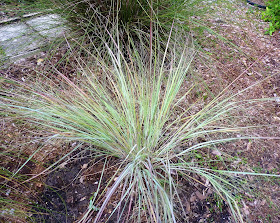One of our favorite vines in My Florida Backyard is the Passion Vine. It's easy to grow (almost too easy), serves as a larval host plant for several butterflies, and has amazing flowers. Till now, we've grown the native
Passiflora incarnata with its
stunning purple flowers. We also started some
P. incarnata "Alba"
from seed this year, which has amazing white flowers, but it has yet to put on any blooms - we're being patient.
We were also fortunate this year to get our hands on some
Passiflora suberosa, another native Passion Vine. More commonly known as Corky Stem Passion Vine, it isn't showy and vibrant like its cousins. Instead, the flowers are tiny and delicate, easily missed but so worth the discovery.
Corky Stem Passion Vine tends to grow best in the shade or partial shade. Because of this, it's often preferred by Zebra Longwing butterflies when they lay their eggs. Early fall is generally when Zebra Longwings start to appear in My Florida Backyard, and we hope to see some soon laying eggs on this simple little vine. (Gulf Fritillaries and Julias will also use this vine as a host plant.)
We got our Corky Stem as a cutting from a friend, as you almost never see them in nurseries. It was easy to grow from a cutting - we placed it in water until roots showed, then kept it in most soil while it began to grow. When it seemed strong and healthy, we transplanted it outside. You can also grow this vine from the seeds of the berries -
see this site for more info.
All the
native Florida Passion Vines have a place in a wildlife garden, although its true that they can become pretty aggressive if allowed to. Generally, however, once they start to grow and
Gulf Fritillary butterflies discover them, nature will easily keep the balance. Beware the non-native Passion Vines, though... the red-flowered
Passiflora coccinea is from South America and the leaves are toxic to our native caterpillars, even though the butterflies will sometimes lay eggs on them. Stick to the natives, and you'll draw butterflies by the dozen for your reward!























